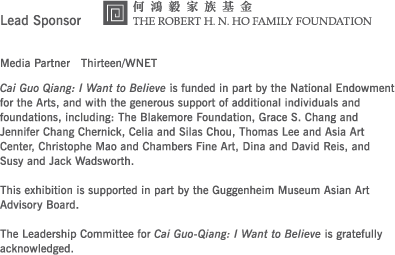CAI GUO-QIANG: I want to believe
February 22-May 28, 2008

The Century with Mushroom Clouds: Project for the 20th Century, 1996. Realized at various sites in the United States, February–April 1996, 1 second each explosion. Gunpowder (10 g each) and cardboard tubes. At Nevada Test Site, February 13, 1996. Photo: Hiro Ihara, courtesy Cai Studio
Watch the Cai Guo-Qiang: I Want to Believe |
overviewCAI GUO-QIANG has literally exploded the accepted parameters of art making in our time. Drawing freely from ancient mythology, military history, Taoist cosmology, extraterrestrial observations, Maoist revolutionary tactics, Buddhist philosophy, gunpowder-related technology, Chinese medicine, and methods of terrorist violence, Cai’s art is a form of social energy, constantly mutable, linking what he refers to as “the seen and unseen worlds.” This retrospective presents the full spectrum of the artist’s protean, multimedia art in all its conceptual complexity. Born in Quanzhou, Fujian Province, China, in 1957, Cai studied stage design at the Shanghai Drama Institute. In the 1980s he emerged as a member of the burgeoning experimental art world of China’s postreform era. After moving to Japan in 1986, Cai tapped into a rich vein of international 20th-century art and critical thought. While living there, he mastered the use of gunpowder to create his signature gunpowder drawings and the related outdoor explosion events. These practices integrate science and art in a process of creative destruction and reflect Cai’s philosophy that conflict and transformation are interdependent conditions of life, and hence art. At once intuitive and analytical, his gunpowder drawings and explosion events are intrepid, conceptual, site specific, ephemeral, time based, and interactive—performance art with a new matrix of cultural meaning. Cai has lived in New York since 1995. While increasing his participation in the global art system of biennials, public celebrations, and museum exhibitions around the world, Cai’s social projects engage local communities to produce art events in remote, nonart sites like military bunkers, a socialist utopianism influenced by Cai’s experience growing up in Mao Zedong’s Red China and during the Cultural Revolution of 1966–76. His recent work has expanded to include large-scale installations, allegorical and sculptural, that recuperate signs and symbols of Chinese culture and expose the dialectics of local history and globalization. Designed by the artist as a site-specific installation, the Guggenheim’s exhibition presents art as a process that unfolds in time and space, dealing with ideas of transformation, expenditure of materials, and connectivity. The structure of Cai’s art forms are inherently unstable, but his social idealism characterizes all change, however violent, as carrying the seeds of positive creation. Subverting tropes such as East versus West, traditional versus contemporary, center versus periphery, Cai offers a new cultural paradigm for the art of a global age and expands the meaning of the phrase “I want to believe.”
All works by Cai Guo-Qiang © 2008 Cai Guo-Qiang. Used by permission. All rights reserved. I Want to Believe™ is used with permission of Twentieth Century Fox Film Corporation. All rights reserved. |
